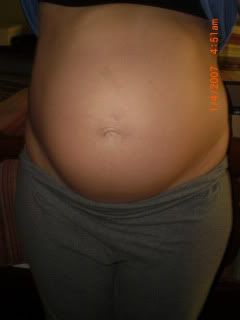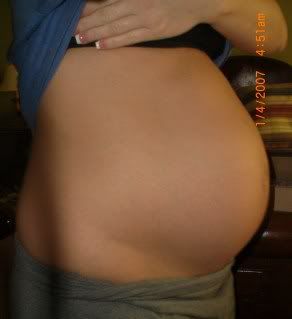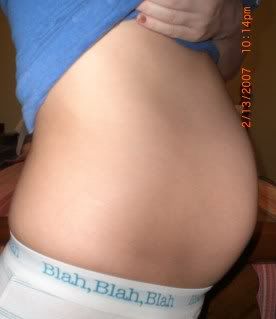Baby Update:
Weel 7 - Your baby's head is the largest part of the body - indicative of the rapid brain growth that has been occurring. All four chambers of the heart are now in place. Intestines are also developing but they are not yet encased inside your baby's body as yet. They bulge out into the umbilical cord. The crown to rump length of your growing baby measures at 4 to 5 mm (0.16-0.2 in).
Week 8 - At about 36 days of development, your baby's ears begin to assume a more human shape. The baby is starting to resemble a newborn. The facial muscles begin to develop, the eyes begin to develop color, the eye muscles begin to form, the eyelids start to develop and the nerve fibers that connect the nose to the brain begin to form. In the heart, the valves are present and distinct. The body's trunk area is getting longer and straightening out. Elbows are present, and arms and legs extend forward. By the end of this week, your baby will be about 1.4-2cm (½ to ¾ in).
Week 9 - Your baby is now a little more than an inch long roughly the size of a large grape, 2.2-3cm (1-1¼ in). Your baby's arms and legs are longer. The head is more erect, and the neck more developed. The eyelids almost cover the eyes. External ears are evident and well formed. Your baby now makes some movements and this can be captured via an ultrasound exam. The baby looks more recognizable as a human being, although it is still extremely tiny. It is not possible to make a distinction between a male and a female baby at this point.
Week 10 - The end of week 10 is the end of the embryonic period and marks the beginning of the fetal period. Most congenital defects occur before the end of week 10. The critical part of your baby's development is safely behind you. Few malformations occur during the fetal period. However it is still advisable to avoid severe stress or radiation. The tubes in your baby's lungs are fully formed and his intestines have migrated from the umbilical cord into the abdominal cavity. Your baby's taste buds start to develop and if your baby is a girl, her ovaries start to descend into the pelvis. Your baby is still very lightweight and measures about 1½ to 1¾ inch long 3.1-4.2cm and weighs close to just 1/30th of an oz or 0.18 oz (5g).
Week 11 - Your baby is approximately 1¾ - 2½ inches (4.4-6 cm) in length and weighs about 0.3 oz (8gm). Your baby is about the size of a large lime. Fetal growth is rapid now. The head makes up nearly half of its length. Fingernails appear. Your baby's external genitalia are beginning to show more distinguishing features and within another 3 weeks, the sex differentiation process will be complete. If a miscarriage occurs after this point, it may be possible to tell the gender. All embryos begin life looking the same, as far as outward appearance is concerned.
Week 12 - Your baby is about 2½ inches (6cm) long and weighs ¼ of an oz. Small amount of hair are beginning to cover baby's body, fingernails and toenails are beginning to grow, and your baby's first permanent tooth buds are forming. The digestive system is able to produce contractions that push food through the bowels. It is also able to absorb sugar. The thyroid gland has started to function and the fetal nervous system is beginning to mature. The amniotic sac which houses your baby contains about 1½ oz of fluid and by the time you deliver, the sac will contain about 3-4 cups of fluid. Your doctor is able to detect baby's heartbeat from now on using a Doppler. Your baby is moving inside your uterus but you probably won't feel it for a while yet.
Week 13 - Your baby is growing rapidly; its growth is particularly noticeable from now through about 24 weeks. The baby has doubled in length since the 7th week, measuring at 2½ to 3 inches long (6.5-7.8cm) and weighing at about ½ and ¾ oz (13-20g) roughly the size of a peach. Changes in the fetal weight have also been tremendous during the last 8-10 weeks of pregnancy. One interesting change is the slowdown in growth of baby's head compared to the rest of the body. By week 21 the head is about one third of the baby's body and at birth baby's head is only ¼ the size of its body. Baby's body accelerates in growth as the fetal head slows down in growth. Baby's face is more human like now; eyes that started out at the sides are now closer together on the face. External genitalia have developed enough so a male can be distinguished from a female baby. Your baby's vocal cords have begun to form. Your baby's hand is structurally complete and consists of 27 bones held together by a complex network of ligaments. Similarly baby's foot is also completely formed with the toes, heel and bones all in place.
Week 14 - While in the first trimester the focus was on the creation of the various body systems, from this point on the emphasis will be on fetal growth. Your baby will start growing at a rapid rate. In fact this month alone your baby will be doubling in length and quadrupling in weight. Your baby's ears have moved from the neck to the sides of the head. Eyes have been gradually moving from the side of the head to the front of the face. The neck continues to get longer, and the chin no longer rests on the chest. Sexual development continues. It is even more obvious to tell a male baby from a female baby just by looking at the external genitalia. Your baby is the size of your fist measuring at about 4 inches (about 9cm) and weighing almost 1 oz (25g). If you enjoy listening to your baby's heartbeat, devices are now available so you can listen at home. Some people believe this activity helps a couple bond with their baby.
Week 15 - Your baby is about 4½ inches long and weighs just under 2 oz. Baby's skin is translucent and covered with downy hair called lanugo. While your baby is moving quite a bit you are not able to tell yet until a couple of weeks later. By this time your baby may be sucking its thumb. Eyes continue to move to the front of the face but are still widely spaced. Ears continue to develop externally. Bones that have already formed are hardening and ossifying (retaining calcium) rapidly. If an X-ray were done at this time, your baby's skeleton would be visible. Your baby looks more human with each passing day.
Week 16 - Your baby is swimming in a tiny pool of amniotic fluid (about a cup of fluid has accumulated inside of you at this stage). This fluid plays an important role in the development of your baby's pulmonary system. The amniotic fluid allows your baby to breathe in the utero as the fluid moves in and out of baby's lungs. The fluid also provides protection to baby as it contains antibiotic agents to inhibit bacterial growth hence your baby is protected prior to its birth. The umbilical cord is attached to the lower part of baby's body. Legs are longer than arms and both limbs move; this can be captured on the ultrasound screen. Some women may also start to feel their baby move at this point of pregnancy; these feelings have been compared to gas bubbles. Many women do not recognize the feeling and may attribute it to being gas bubbles when actually it is their baby moving. Your baby measures at about 4½ inches (11.5 cm) and weighs close to 2¾ oz (80g).
Week 17 - Your baby now measures at 4½ to 4¾ inches long (11-12cm) and weighs about 3½ oz (100g) now. Baby is now the size of your hand spread open wide. Fat or adipose tissue begins to form beginning from this week and continues for some weeks to come; fat is important to the heat production and metabolism. Water makes up about 3 oz (89g) of your baby's body. If it is a girl baby, her fallopian tubes are formed around this time. If you have not felt your baby move, you will soon. These movements may not be felt everyday but as pregnancy progresses these movements grow stronger and more frequent.
Is This Karma????
14 years ago






